[English] 日本語
 Yorodumi
Yorodumi- PDB-1cfb: CRYSTAL STRUCTURE OF TANDEM TYPE III FIBRONECTIN DOMAINS FROM DRO... -
+ Open data
Open data
- Basic information
Basic information
| Entry | Database: PDB / ID: 1cfb | |||||||||
|---|---|---|---|---|---|---|---|---|---|---|
| Title | CRYSTAL STRUCTURE OF TANDEM TYPE III FIBRONECTIN DOMAINS FROM DROSOPHILA NEUROGLIAN AT 2.0 ANGSTROMS | |||||||||
 Components Components | DROSOPHILA NEUROGLIAN | |||||||||
 Keywords Keywords | NEURAL ADHESION MOLECULE | |||||||||
| Function / homology |  Function and homology information Function and homology informationpleated septate junction / melanotic encapsulation of foreign target / central complex development / regulation of tube size, open tracheal system / imaginal disc morphogenesis / regulation of female receptivity / cell adhesion involved in heart morphogenesis /  septate junction / septate junction /  septate junction assembly / establishment of glial blood-brain barrier ...pleated septate junction / melanotic encapsulation of foreign target / central complex development / regulation of tube size, open tracheal system / imaginal disc morphogenesis / regulation of female receptivity / cell adhesion involved in heart morphogenesis / septate junction assembly / establishment of glial blood-brain barrier ...pleated septate junction / melanotic encapsulation of foreign target / central complex development / regulation of tube size, open tracheal system / imaginal disc morphogenesis / regulation of female receptivity / cell adhesion involved in heart morphogenesis /  septate junction / septate junction /  septate junction assembly / establishment of glial blood-brain barrier / nerve maturation / photoreceptor cell axon guidance / mushroom body development / female courtship behavior / male courtship behavior / axon ensheathment / neuron cell-cell adhesion / axon extension / motor neuron axon guidance / dendrite morphogenesis / plasma membrane => GO:0005886 / bicellular tight junction / septate junction assembly / establishment of glial blood-brain barrier / nerve maturation / photoreceptor cell axon guidance / mushroom body development / female courtship behavior / male courtship behavior / axon ensheathment / neuron cell-cell adhesion / axon extension / motor neuron axon guidance / dendrite morphogenesis / plasma membrane => GO:0005886 / bicellular tight junction /  cell adhesion molecule binding / cell adhesion molecule binding /  axonogenesis / axonogenesis /  filopodium / synapse organization / filopodium / synapse organization /  cell-cell adhesion / cell-cell adhesion /  axon / axon /  dendrite / neuronal cell body / dendrite / neuronal cell body /  calcium ion binding / calcium ion binding /  plasma membrane plasma membraneSimilarity search - Function | |||||||||
| Biological species |   Drosophila melanogaster (fruit fly) Drosophila melanogaster (fruit fly) | |||||||||
| Method |  X-RAY DIFFRACTION / Resolution: 2 Å X-RAY DIFFRACTION / Resolution: 2 Å | |||||||||
 Authors Authors | Huber, A.H. / Wang, Y.E. / Bieber, A.J. / Bjorkman, P.J. | |||||||||
 Citation Citation |  Journal: Neuron / Year: 1994 Journal: Neuron / Year: 1994Title: Crystal structure of tandem type III fibronectin domains from Drosophila neuroglian at 2.0 A. Authors: Huber, A.H. / Wang, Y.M. / Bieber, A.J. / Bjorkman, P.J. #1:  Journal: Cell(Cambridge,Mass.) / Year: 1989 Journal: Cell(Cambridge,Mass.) / Year: 1989Title: Drosophila Neuroglian: A Member of the Immunoglobulin Superfamily with Extensive Homology to the Vertebrate Neural Adhesion Molecule L1 Authors: Bieber, A.J. / Snow, P.M. / Hortsch, M. / Patel, N.H. / Jacobs, J.R. / Traquina, Z.R. / Schilling, J. / Goodman, C.S. | |||||||||
| History |
| |||||||||
| Remark 700 | SHEET THIS STRUCTURE CONTAINS SEVERAL "CLASSIC" AND "WIDE" BETA-BULGES AS DESCRIBED BY J.S. ...SHEET THIS STRUCTURE CONTAINS SEVERAL "CLASSIC" AND "WIDE" BETA-BULGES AS DESCRIBED BY J.S.RICHARDSON, E.D.GETZOFF AND D.C.RICHARDSON IN "THE BETA-BULGE: A COMMON SMALL UNIT OF NONREPETITIVE PROTEIN STRUCTURE, "PROC.NATL.ACAD.SCI. USA, VOL. 75, PP. 2574 - 2578, 1978 RESIDUES TYPE OF BETA-BULGE THR 621, GLY 622 CLASSIC LEU 645, HIS 646 CLASSIC ALA 663, TYR 664 CLASSIC GLU 665, LYS 666 WIDE ASN 719, VAL 720 WIDE ASN 746, PHE 747 WIDE |
- Structure visualization
Structure visualization
| Structure viewer | Molecule:  Molmil Molmil Jmol/JSmol Jmol/JSmol |
|---|
- Downloads & links
Downloads & links
- Download
Download
| PDBx/mmCIF format |  1cfb.cif.gz 1cfb.cif.gz | 59.2 KB | Display |  PDBx/mmCIF format PDBx/mmCIF format |
|---|---|---|---|---|
| PDB format |  pdb1cfb.ent.gz pdb1cfb.ent.gz | 45.8 KB | Display |  PDB format PDB format |
| PDBx/mmJSON format |  1cfb.json.gz 1cfb.json.gz | Tree view |  PDBx/mmJSON format PDBx/mmJSON format | |
| Others |  Other downloads Other downloads |
-Validation report
| Arichive directory |  https://data.pdbj.org/pub/pdb/validation_reports/cf/1cfb https://data.pdbj.org/pub/pdb/validation_reports/cf/1cfb ftp://data.pdbj.org/pub/pdb/validation_reports/cf/1cfb ftp://data.pdbj.org/pub/pdb/validation_reports/cf/1cfb | HTTPS FTP |
|---|
-Related structure data
| Similar structure data |
|---|
- Links
Links
- Assembly
Assembly
| Deposited unit | 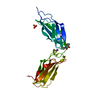
| ||||||||
|---|---|---|---|---|---|---|---|---|---|
| 1 |
| ||||||||
| 2 | 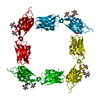
| ||||||||
| Unit cell |
| ||||||||
| Atom site foot note | 1: THE FOLLOWING RESIDUES HAVE SOME POORLY DEFINED SIDE CHAIN ATOMS: LYS 629, LYS 693, GLU 726, LYS 754 AND LYS 789. THESE ATOMS WERE EXCLUDED FROM REFINEMENT AND HAVE BEEN GIVEN AN OCCUPANCY OF 0.00 ...1: THE FOLLOWING RESIDUES HAVE SOME POORLY DEFINED SIDE CHAIN ATOMS: LYS 629, LYS 693, GLU 726, LYS 754 AND LYS 789. THESE ATOMS WERE EXCLUDED FROM REFINEMENT AND HAVE BEEN GIVEN AN OCCUPANCY OF 0.00 AND A B VALUE OF 99.99 IN THIS ENTRY. 2: THIS STRUCTURE CONTAINS SEVERAL "CLASSIC" AND "WIDE" BETA-BULGES AS DESCRIBED BY J.S.RICHARDSON, E.D.GETZOFF AND D.C.RICHARDSON IN "THE BETA-BULGE: A COMMON SMALL UNIT OF NONREPETITIVE PROTEIN ...2: THIS STRUCTURE CONTAINS SEVERAL "CLASSIC" AND "WIDE" BETA-BULGES AS DESCRIBED BY J.S.RICHARDSON, E.D.GETZOFF AND D.C.RICHARDSON IN "THE BETA-BULGE: A COMMON SMALL UNIT OF NONREPETITIVE PROTEIN STRUCTURE, "PROC.NATL.ACAD.SCI. USA, VOL. 75, PP. 2574 - 2578, 1978. RESIDUES TYPE OF BETA-BULGE THR 621, GLY 622 CLASSIC LEU 645, HIS 646 CLASSIC ALA 663, TYR 664 CLASSIC GLU 665, LYS 666 WIDE ASN 719, VAL 720 WIDE ASN 746, PHE 747 WIDE |
- Components
Components
-Protein , 1 types, 1 molecules A
| #1: Protein | Mass: 23043.385 Da / Num. of mol.: 1 Source method: isolated from a genetically manipulated source Source: (gene. exp.)   Drosophila melanogaster (fruit fly) / Cell line: S2 / Gene: POTENTIAL / References: UniProt: P20241 Drosophila melanogaster (fruit fly) / Cell line: S2 / Gene: POTENTIAL / References: UniProt: P20241 |
|---|
-Sugars , 2 types, 2 molecules 
| #2: Polysaccharide | 2-acetamido-2-deoxy-beta-D-glucopyranose-(1-4)-2-acetamido-2-deoxy-beta-D-glucopyranose / Mass: 424.401 Da / Num. of mol.: 1 / Mass: 424.401 Da / Num. of mol.: 1Source method: isolated from a genetically manipulated source |
|---|---|
| #3: Sugar | ChemComp-NAG /  N-Acetylglucosamine N-Acetylglucosamine |
-Non-polymers , 3 types, 239 molecules 




| #4: Chemical | ChemComp-SO4 /  Sulfate Sulfate |
|---|---|
| #5: Chemical | ChemComp-NA / |
| #6: Water | ChemComp-HOH /  Water Water |
-Details
| Compound details | AT LEAST TWO OF THE PROTEIN'S THREE POTENTIAL N-LINKED GLYCOSYLATION SITES ARE UTILIZED. ELECTRON ...AT LEAST TWO OF THE PROTEIN'S THREE POTENTIAL N-LINKED GLYCOSYLAT |
|---|
-Experimental details
-Experiment
| Experiment | Method:  X-RAY DIFFRACTION X-RAY DIFFRACTION |
|---|
- Sample preparation
Sample preparation
| Crystal | Density Matthews: 6.39 Å3/Da / Density % sol: 80.75 % | ||||||||||||||||||||||||
|---|---|---|---|---|---|---|---|---|---|---|---|---|---|---|---|---|---|---|---|---|---|---|---|---|---|
Crystal grow | *PLUS pH: 7.5 / Method: vapor diffusion, hanging drop | ||||||||||||||||||||||||
| Components of the solutions | *PLUS
|
-Data collection
| Radiation | Scattering type: x-ray |
|---|---|
| Radiation wavelength | Relative weight: 1 |
| Reflection | *PLUS Highest resolution: 1.8 Å / Num. obs: 45766 / Num. measured all: 355936 / Rmerge(I) obs: 0.05 |
- Processing
Processing
| Software |
| ||||||||||||||||||||||||||||||||||||||||||||||||||||||||||||
|---|---|---|---|---|---|---|---|---|---|---|---|---|---|---|---|---|---|---|---|---|---|---|---|---|---|---|---|---|---|---|---|---|---|---|---|---|---|---|---|---|---|---|---|---|---|---|---|---|---|---|---|---|---|---|---|---|---|---|---|---|---|
| Refinement | Resolution: 2→5 Å Details: THE FOLLOWING RESIDUES HAVE SOME POORLY DEFINED SIDE CHAIN ATOMS: LYS 629, LYS 693, GLU 726, LYS 754 AND LYS 789. THESE ATOMS WERE EXCLUDED FROM REFINEMENT AND HAVE BEEN GIVEN AN OCCUPANCY ...Details: THE FOLLOWING RESIDUES HAVE SOME POORLY DEFINED SIDE CHAIN ATOMS: LYS 629, LYS 693, GLU 726, LYS 754 AND LYS 789. THESE ATOMS WERE EXCLUDED FROM REFINEMENT AND HAVE BEEN GIVEN AN OCCUPANCY OF 0.00 AND A B VALUE OF 99.99 IN THIS ENTRY.
| ||||||||||||||||||||||||||||||||||||||||||||||||||||||||||||
| Refinement step | Cycle: LAST / Resolution: 2→5 Å
| ||||||||||||||||||||||||||||||||||||||||||||||||||||||||||||
| Refine LS restraints |
| ||||||||||||||||||||||||||||||||||||||||||||||||||||||||||||
| Software | *PLUS Name:  X-PLOR / Classification: refinement X-PLOR / Classification: refinement | ||||||||||||||||||||||||||||||||||||||||||||||||||||||||||||
| Refinement | *PLUS σ(F): 3 / Rfactor all : 0.202 / Rfactor obs: 0.195 / Rfactor Rfree : 0.202 / Rfactor obs: 0.195 / Rfactor Rfree : 0.235 : 0.235 | ||||||||||||||||||||||||||||||||||||||||||||||||||||||||||||
| Solvent computation | *PLUS | ||||||||||||||||||||||||||||||||||||||||||||||||||||||||||||
| Displacement parameters | *PLUS | ||||||||||||||||||||||||||||||||||||||||||||||||||||||||||||
| Refine LS restraints | *PLUS Type: x_angle_d / Dev ideal: 1.9 |
 Movie
Movie Controller
Controller


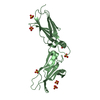
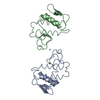
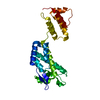
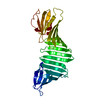
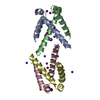
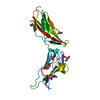
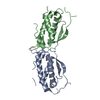
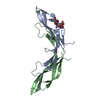
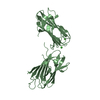
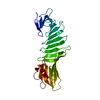
 PDBj
PDBj










